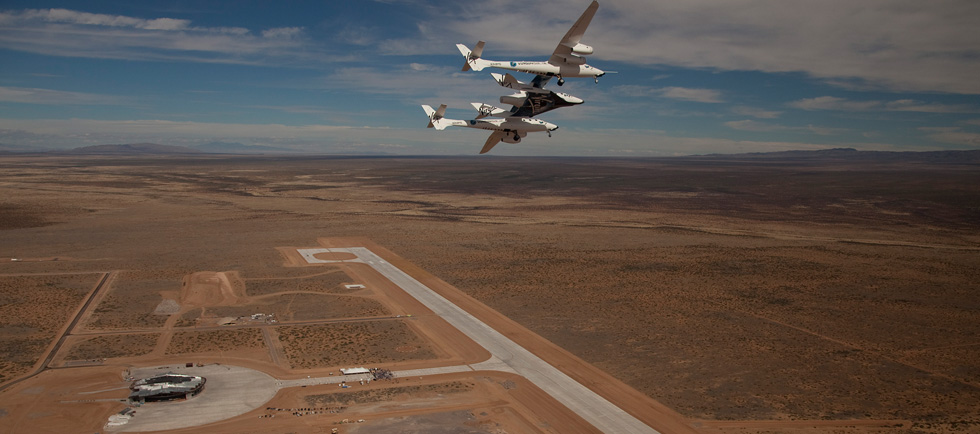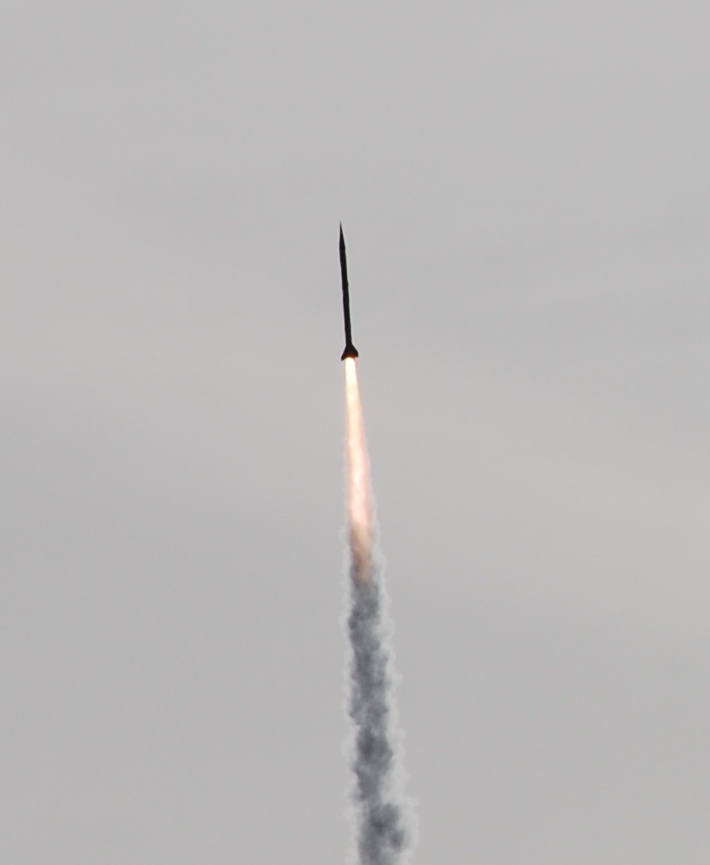Spaceport America Milestones: Record Rocket Launch, Runway Add-On

Spaceport America carried out a vertical rocket launch this month, with a sounding rocket hurling payloads to a record altitude above the complex in New Mexico.
Meanwhile, a Phase Two spaceport construction and evolution decision has been made to add an extra runway to the already finished, nearly two-mile-long "Spaceway" at Spaceport America.
That runway is to support operations of Virgin Galactic, the spaceline firm bankrolled by adventurer and entrepreneur Richard Branson. Virgin Galactic is the spaceport’s anchor tenant and will use the facility to support suborbital space tourism flights using the WhiteKnightTwo/SpaceShipTwo launch system.
Spaceport America is the first purpose-built commercial spaceport in the world. It is situated in Upham, N.M., on 18,000 acres adjacent to the U.S. Army's White Sands Missile Range. [Photos: Take a Tour of Spaceport America]
Customers of the spaceport also include Armadillo Aerospace, UP Aerospace, MOOG FTS and Lockheed Martin.
Vertical launch
The UP Aerospace launch of its SpaceLoft rocket on April 5 marked the 15th vertical launch overall from the Spaceport America Vertical Launch Complex. The launch was an unpublicized event not open to the public at the request of UP Aerospace Inc.
Breaking space news, the latest updates on rocket launches, skywatching events and more!
The primary customer for the launch was the Department of Defense Operationally Responsive Space Office. Additional payloads were carried for the Federal Aviation Administration, the University of Texas and NASA.
The rocket achieved an altitude record at the spaceport of 385,640 feet (71 miles).
"A perfect launch…all systems functioned as planned," said Jerry Larson, president of UP Aerospace Inc. of Highlands Ranch, Colo.
Larson told SPACE.com that the rocket’s payloads were returned to the spaceport by an Army helicopter about one and a half hours after the launch. All the payloads were removed and given back to their respective "payloaders" within two and a half hours after liftoff, he said.
On the rocket launch was the first NASA Flight Opportunities Program payload, Larson said. FOP is carried out under NASA’s Office of the Chief Technologist. The FOP payload was a Suborbital Flight Environment Monitor system built by NASA Ames Research Center.
"Next on deck is the first fully manifested SpaceLoft launch for the NASA FOP scheduled for this August," Larson added. "We also have another two SpaceLoft launches tentatively planned for this year. Next year is shaping up to be very busy with as many as five to six SpaceLoft launches."

Spaceway addition
In anticipation of Virgin Galactic operations starting at Spaceport America in 2013, a decision was made to lengthen a specially built runway to support suborbital passenger flights.
"We are adding an additional 2,000 feet to our existing 10,000-foot runway at Spaceport America to accommodate Virgin Galactic's requirements and also to attract other tenants," said Christine Anderson, executive director of the New Mexico Spaceport Authority. [Video: SpaceShipTwo's First Solo Glide Flight]
Anderson told SPACE.com that the need for this extension recently became better defined as Virgin Galactic performed more testing on their vehicle.
"We have re-prioritized our phase 2 budget so that we can fund this requirement in the near term," Anderson said. "We believe this is absolutely the right thing to do and have already started the design development."
According to the Las Cruces Sun-News, spaceport officials approved $7 million to extend the Spaceport America runway.
Rick Holdridge, chairman of the New Mexico Spaceport Authority, said the authority assigned one of its members, former NASA astronaut Sid Gutierrez, to review whether the proposed extension was merited. Gutierrez concluded it was, reported Holdridge in the Las Cruces Sun-News story.
Higher takeoff and landing speeds
“We applaud the decision of the New Mexico Spaceport Authority to lengthen the runway at Spaceport America. It is a welcome enhancement to address the unique influences of the location on flight vehicle performance and safety margins,” said Jeff Carr, a spokesman for Virgin Galactic.
Carr said that the relatively low air density — due to high airfield altitude — when coupled with the high temperatures at the New Mexico site, can require higher takeoff and landing speeds of craft, as well as increased rollout distances.
“This extension allows a wider margin for performance in normal as well as various contingency scenarios, enabling us to operate more safely, within reasonable constraints, from the site on a year-round basis,” Carr said.
Rocket motor test
In related Virgin Galactic news, the hybrid rocket motor necessary to power suborbital space treks of paying customers underwent a ground test last month at the Mojave Air and Space Port. It was the ninth full-scale flight design rocket motor two hot-fire.
According to a Scaled Composites March 13 test summary: "All objectives completed. Performed full 45-second hot fire as planned. Duration of burn chosen to allow examination of internal core geometry."
The hybrid nitrous oxide rocket motor system is provided by subcontractor Sierra Nevada Corp.
This motor will power SpaceShipTwo into suborbital space, to heights over 65 miles (110 kilometers) above the Earth’s surface, with the spaceship gliding back down through the atmosphere for a touchdown.
"Sierra Nevada did the latest ground test…which went well, and there will be another coming up soon," said George Whitesides, CEO and president of Virgin Galactic.
WhiteKnightTwo carrier planes and the six-passenger/two-pilot SpaceShipTwo are being built at The Spaceship Co. in Mojave, Calif. TSC is a joint venture between Virgin Galactic and Scaled Composites.
Leonard David has been reporting on the space industry for more than five decades. He is a winner of last year's National Space Club Press Award and a past editor-in-chief of the National Space Society's Ad Astra and Space World magazines. He has written for SPACE.com since 1999.
Join our Space Forums to keep talking space on the latest missions, night sky and more! And if you have a news tip, correction or comment, let us know at: community@space.com.

Leonard David is an award-winning space journalist who has been reporting on space activities for more than 50 years. Currently writing as Space.com's Space Insider Columnist among his other projects, Leonard has authored numerous books on space exploration, Mars missions and more, with his latest being "Moon Rush: The New Space Race" published in 2019 by National Geographic. He also wrote "Mars: Our Future on the Red Planet" released in 2016 by National Geographic. Leonard has served as a correspondent for SpaceNews, Scientific American and Aerospace America for the AIAA. He has received many awards, including the first Ordway Award for Sustained Excellence in Spaceflight History in 2015 at the AAS Wernher von Braun Memorial Symposium. You can find out Leonard's latest project at his website and on Twitter.
